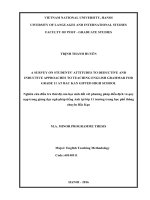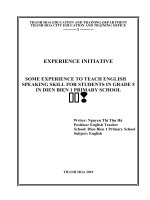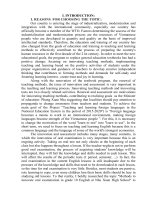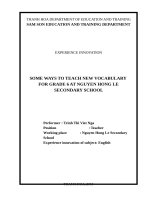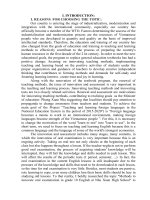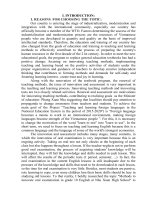AMERICAN REVOLUTION to Complement Houghton-Mifflin Reading Series (Grade 5, Theme 3) La Mesa-Spring Valley School District Adapted from Fountain Valley School District – American Revolution Unit
Bạn đang xem bản rút gọn của tài liệu. Xem và tải ngay bản đầy đủ của tài liệu tại đây (982.89 KB, 91 trang )
AMERICAN REVOLUTION
to Complement Houghton-Mifflin Reading Series (Grade 5, Theme 3)
La Mesa-Spring Valley School District
Adapted from Fountain Valley School District – American Revolution Unit
IDEA PAGES
I. UNIT THEME
• Freedom: rights and responsibilities
• Different Americans experienced the Revolution differently
• Freedom for whom?
II. FOCUS/MOTIVATION
• Everybody votes
• Laser Disc
• Big Book
• Inquiry Chart
• Read Aloud
• Video clip
• Personal inquiry
III. CLOSURE
• Student-generated test
• Cause/effect chart
• Portfolio
- expository
- persuasive letter
- found poem
- biography
• Process inquiry and all charts
• Personal exploration
• Debate
IV.
CONCEPTS - History/Social Studies - GRADE 5 CALIFORNIA STANDARDS
5.3 Students describe the cooperation and conflict that existed among the Indians and between the
Indian nations and the settlers.
1. Competition among the English, French, Spanish, Dutch, and Indian Nations for control of
North America.
2. Cooperation that existed between the colonists and Indians during the 1600s and 1700s.
3. Conflicts before the Revolutionary War.
4. Role of broken treaties and massacres and the factors that lead to the Indians' defeat, including
the resistance of Indian nations to encroachments and assimilation.
5. Internecine Indian conflicts, including the competing claim for control.
6. Influence and achievements of significant leaders of time.
5.4 Students understand the political, religious, social, and economic institutions
that evolved in the colonial era
1. Influence of location and physical setting on the founding of the original 13 colonies,
their location on a map along with the location of the American Indian nations already
inhabiting these areas.
2. Major individuals and groups responsible for the founding of the various colonies and
the reasons for their founding.
3. Religious aspects of the earliest colonies.
4. Significance and leaders of the First Great Awakening that marked a shift in religious
ideas, practices and allegiances in the colonial period; the growth of religious toleration
and free exercise.
5. The British colonial period created the basis for the development of political self
government and a free market economic system, unlike Spanish and French colonial rule.
6. Introduction of slavery into America, the responses of slave families to their condition, the ongoing
struggle between proponents and opponents of slavery, and the gradual institutionalization of slavery in
the South.
7. Early democratic ideas and practices that emerged during the colonial period, including the
significance of representative assemblies and town meetings.
5.5
Students explain the causes of the American Revolution.
1. Political, religious, and economic ideas and interests brought about the Revolution.
2. Significance of the first and second Continental Congress and the Committees of Correspondence.
3. People and events associated with the drafting and signing of the Declaration of
Independence and the document's significance, including the key political concepts it
embodies, the origins of those concepts, and its role in severing ties with Great Britain.
4. Views, lives, and impact of key individuals during this period.
5.6
Students understand the course and consequences of the American Revolution.
1. Identify and map the major military battles, campaigns and turning points of the
Revolutionary War, the roles of the American and British leaders, and the Indian leaders'
alliances on both sides.
2. Contributions of France and other nations and individuals to the outcome of the
Revolution.
3. Different roles women played during the Revolution.
4. Personal impact and economic hardship on families, problems of financing the war,
wartime inflation, and laws against hoarding and profiteering.
5. State constitutions established after 1776 embodied the ideals of the American
Revolution and helped serve as models for the US Constitution.
6. Significance of land policies developed under the Continental Congress.
7. Ideals of the Declaration of Independence changed the way people viewed slavery.
ELA CALIFORNIA STANDARDS - Grade 5
V. ORAL LANGUAGE/READING/WRITING SKILLS
READING
1.0 Word Analysis, Fluency, and Systematic Vocabulary
Students use their knowledge of word origins and word relationships, as well as historical and
literacy context clues, to determine the meaning of specialized vocabulary and to understand the
precise meaning of grade-level-appropriate words.
Word Recognition
1.1 Read aloud narrative and expository text fluently and accurately and with appropriate pacing,
intonation, and expression.
Vocabulary and Concept Development
1.2 Use word origins to determine the meaning of unknown words.
1.3 Understand and explain frequently used synonyms, antonyms, and homographs.
I.4 Know abstract, derived roots and affixes from Greek and Latin and use this
knowledge to analyze the meaning of complex words.
2.0 Reading Comprehension
2.1 Understand how text features make information accessible and usable.
2.2 Analyze text that is organized in sequential or chronological order
2.3 Discern main ideas and concepts presented in texts, identifying and assessing
evidence that supports those ideas.
2.4 Draw inferences, conclusions, or generalizations about text and support them
with textual evidence and prior knowledge.
2.5 Distinguish facts, supported inferences, and opinions in text.
3.0 Literary Response and Analysis
3.1 Identify and analyze the characteristics of poetry, drama, fiction, and non-fiction and explain
the appropriateness of the literary forms chosen by an author for a specific purpose.
3.2 Identify the main problem or conflict of the plot and explain how it is resolved.
3.3 Contrast the actions, motives and appearances of characters in a work of
fiction and discuss the importance of the contrasts to the plot or theme.
3.4 Understand that theme refers to the meaning or moral of a selection and
recognize themes in sample works.
3.5 Describe the function and effect of common literary devices.
3.6 Evaluate the meaning of archetypal patterns and symbols that are found in
myth and tradition by using literature from different eras and cultures.
3.7 Evaluate the author's use of various techniques to influence readers' perspectives.
WRITING
1.0
Writing Strategies
1.1 Create multiple-paragraph narrative compositions:
a. Establish and develop a situation or plot.
b. Describe setting.
c. Present an ending.
1.2 Create multiple-paragraph expository compositions:
a. Establish a topic, important ideas, or events in sequence or chronological order.
b. Provide details and transitional expressions that link one paragraph to another in a clear
line of thought.
c. Offer a concluding paragraph that summarizes important ideas and details.
1.3 Use organizational features of printed text to locate relevant information.
1.6 Edit and revise manuscripts to improve the meaning and focus of writing by
adding, deleting, consolidating, clarifying, and rearranging words and sentences.
2.0 Writing Applications
2.1 Write narratives:
a. Establish a plot, point of view, setting, and conflict.
b. Show, rather than tell, the events of the story.
2.2 Write responses to literature:
a. Demonstrate an understanding of a literary work.
b. Support judgments through references to the text and to prior knowledge.
c. Develop interpretations that exhibit careful reading and understanding.
2.3 Write research reports about important ideas, issues, or events by using the following
guidelines:
a. Frame questions that direct the investigation.
b. Establish a controlling idea or topic.
c. Develop the topic with simple facts, details, examples, and explanations.
2.4 Write persuasive letters or compositions:
a. State a clear position in support of a proposal.
b. Support a position with relevant evidence.
c. Follow a simple organizational pattern.
d. Address reader concerns.
WRITTEN AND ORAL ENGLISH LANGUAGE CONVENTIONS
1.0 Written and Oral English Language Conventions
Students write and speak with a command of standard English conventions appropriate to
this grade level.
1.1 Identify and correctly use prepositional phrases, appositives, and independent and dependent
clauses; use transitions and conjunctions to connect ideas.
1.2 Identify and correctly use verbs that are often misused, modifiers, and pronouns.
1.3 Use a colon to separate hours and minutes and to introduce a list; use quotation marks around
the exact words of a speaker and titles of poems, songs, short stories, and so forth.
1.4 Use correct capitalization.
LISTENING AND SPEAKING
1.0 Listening and Speaking Strategies
1.1 Ask questions that seek information not already discussed.
1.2 Interpret a speaker's verbal and nonverbal messages, purposes, and perspectives.
1.3 Make inferences or draw conclusions based on an oral report.
1.4 Select a focus, organizational structure, and point of view for an oral presentation.
1.5 Clarify and support spoken ideas with evidence and examples.
1.8 Analyze media as sources for information, entertainment, persuasion, interpretation of events, and
transmission of culture.
2.0 Speaking Applications
2.1 Deliver narrative presentations:
a. Establish a situation, plot, point of view, and setting with descriptive words and phrases.
b. Show, rather than tell, the listener what happens.
2.2 Deliver informative presentations about an important idea, issue, or event by the following means.
a. Frame questions to direct the investigation.
b. Establish a controlling idea or topic.
c. Develop the topic with simple facts, details, examples, and explanations.
Listening and Speaking (Grades 3-5 California ELD Standards)
Comprehension
Beginning Level:
Speak with few words/sentences
Answer simple questions with one/two word response
Retell familiar stories/participate in short conversations/using gestures
Early Intermediate Level:
Ask/answer questions using phrases/simple sentences
Restate/execute multi step oral directions
Intermediate Level:
Ask/answer questions using support elements
Identify key details from stories/information
Early Advanced Level:
Identify main points/support details from content areas
Advanced Level:
Identify main points/support details from stories & subject areas
Respond to & use idiomatic expressions appropriately
Comprehension, Organization & Delivery of Oral Communication
Beginning Level:
Uses common social greetings
Early Intermediate Level:
Identify main points of simple conversations/stories (read aloud)
Communicate basic needs
Recite rhymes/songs/simple stories
Intermediate Level:
Speak with standard English grammatical forms/sounds
Participate in social conversations by asking/answering questions
Retell stories/share school activities using vocabulary, descriptive words/paraphrasing
Early Advanced Level:
Retell stories including characters, setting, plot, summary, analysis
Use standard English grammatical forms/sounds/intonation/pitch
Initiate social conversations by asking & answering questions/restating & soliciting information
Appropriate speaking based on purpose, audience, subject matter
Ask/answer instructional questions
Use figurative language & idiomatic expressions
Advanced Level:
Question/restate/paraphrase in social conversations
Speak/write based on purpose, audience, & subject matter
Identify main idea, point of view, & fact/fiction in broadcast & print media
Use standard English grammatical forms/sounds/intonation/pitch
Reading - Word Analysis (Grades 3-5 California ELD Standards)
Concepts about Print, Phonemic Awareness, Decoding & Word Recognition
Beginning Level:
Recognize familiar phonemes
Recognize sound/symbol relationships in own writing
Early Intermediate Level:
Read orally recognizing/producing phonemes not in primary language
Recognize morphemes in phrases/simple sentences
Intermediate Level:
Read aloud with correct pronunciation of most phonemes
Use common morphemes in oral & silent reading
Early Advanced Level:
Use knowledge of morphemes to derive meaning from literature/texts in content
areas
Advanced Level:
Use roots & affixes to derive meaning
Reading - Fluency & Systematic Vocabulary Development
(Grades 3-5 California ELD Standards)
Vocabulary & Concept Development
Beginning Level:
Read aloud simple words in stories/games
Respond to social & academic interactions (simple questions/answers)
Demonstrate comprehension of simple vocabulary with action
Retell simple stories with drawings, words, phrases
Uses phrases/single word to communicate basic needs
Early Intermediate Level:
Use content vocabulary in discussions/reading
Read simple vocabulary, phrases & sentences independently
Use morphemes, phonics, syntax to decode & comprehend words
Recognize & correct grammar, usage, word choice in speaking or reading aloud
Read own narrative & expository text aloud with pacing, intonation, expression
Intermediate Level:
Create dictionary of frequently used words
Decode/comprehend meaning of unfamiliar words in texts
Recognize & correct grammar, usage, word choice in speaking or reading aloud
Read grade level narrative/expository text aloud with pacing, intonation, expression
Use content vocabulary in discussions/reading
Recognize common roots & affixes
Early Advanced Level:
Use morphemes, phonics, syntax to decode/comprehend words
Recognize multiple meaning words in content literature & texts
Use common roots & affixes
Use standard dictionary to find meanings
Recognize analogies & metaphors in content literature & texts
Use skills/knowledge to achieve independent reading
Use idioms in discussions & reading
Read complex narrative & expository texts aloud with pacing, intonation, expression
Advanced Level:
Apply common roots & affixes knowledge to vocabulary
Recognize multiple meaning words
Apply academic & social vocabulary to achieve independent read.
Use idioms, analogies & metaphors in discussion & reading
Use standard dictionary to find meanings
Read narrative & expository text aloud with pacing, intonation
Reading Comprehension
Beginning Level:
Answer fact questions using one/two word response
Connect simple test read aloud to personal experience
Understand & follow one-step directions
Sequence events from stories read aloud using key words/phrase
Identify main idea using key words/phrases
Identify text features: title/table of contents/chapter headings
Early Intermediate Level:
Use simple sentences to give details from simple stories
Connect text to personal experience
Follow simple two-step directions
Identify sequence of text using simple sentences
Read & identify main ideas to draw inferences
Identify text features: title, table of contents, chapter headings
Identify fact/opinion in grade level text read aloud to students
Intermediate Level:
Orally respond to comprehension questions about written text
Read text features: titles, table of contents, headings, diagrams, charts, glossaries, indexes
Identify main idea to make predictions & support details
Orally describe connections between text & personal experience
Follow multi-step directions for classroom activities
Identify examples of fact/opinion & cause/effect in literature/content texts
Early Advanced Level:
Give main idea with supporting detail from grade level text
Generate & respond to text-related comprehension questions
Describe relationships between text & personal experience
Identify function of text features: format/diagrams/charts/glossary
Draw conclusions & make inferences using text resources
Find examples of fact, opinion, inference, & cause/effect in text
Identify organizational patterns in text: sequence, chronology
Advanced Level:
Make inferences/generalizations, draw conclusions from grade level text resources
Describe main ideas with support detail from text
Identify patterns in text: compare/contrast, sequence/ cause/effect
Writing Strategies and Applications (Grade 3-5 California ELD Standards)
Penmanship, Organization & Focus
Beginning Level:
Write alphabet
Label key parts of common object
Create simple sentences/phrases
Write brief narratives/stories using few standard grammatical forms
Early Intermediate Level:
Write narratives that include setting and character
Respond to literature using simple sentences, drawings, lists, chart
Write paragraphs of at least four sentences
Write words/simple sentences in content areas
Write friendly letter
Produce independent writing
Intermediate Level:
Narrate sequence of events
Produce independent writing
Use variety of genres in writing
Create paragraph developing central idea using grammatical form
Use complex vocabulary & sentences in all content areas
Write a letter with detailed sentences
Early Advanced Level:
Write detailed summary of story
Arrange compositions with organizational patterns
Independently write responses to literature
Use complex vocabulary & sentences in all content areas
Write a persuasive letter with relevant evidence
Produce writing with command of standard conventions
Advanced Level:
Write short narrative for all content areas
Write persuasive composition
Write narratives that describe setting, character, objects, events
Write multi-paragraph narrative & expository compositions
Independently use all steps of writing process
Writing Conventions
Beginning Level:
Begin own name and sentences with capital letter
Use period at end of sentence
Early Intermediate Level:
Begin proper nouns & sentences with capital letter
Use period at end of sentence/use some commas
Edit for basic conventions
Intermediate Level:
Produce independent writing
Use standard word order
Early Advanced Level:
Produce independent writing with correct capitals, punctuation, spelling
Use standard word order
Edit for basic conventions
Advanced Level:
Use complete sentences and correct order
Use correct parts of speech
Edit for punctuation, capitalization, spelling
Produce writing with command of standard conventions
Reading Literary Response and Analysis (Grades 3-5 California ELD Standards)
Narrative Analysis of Grade-Level Appropriate Text
Beginning Level:
One/two-word oral responses to factual comprehension questions
Word/phrase oral response identifying characters and settings
Distinguish between fiction & non-fiction
Identify' fairy tales, folk tale, myth, legend using lists, charts, tables
Early Intermediate Level:
Orally answer factual questions using simple sentences
Orally identify main events in plot
Recite simple poems
Orally describe setting of literature piece
Orally distinguish among poetry, drama, short story
Orally describe character of a selection
Intermediate Level:
Paraphrase response to text using expanded vocabulary
Apply knowledge of language to derive meaning from text
Early Advanced Level:
Describe figurative language (simile, metaphor, personification)
Distinguish literary connotations from culture to culture
Identify motives of characters
Describe themes stated directly
Identify speaker/narrator in text
Identify main problem of plot and how it is resolved
Recognize first & third person in literary text
Advanced Level:
Describe characteristics of poetry, drama, fiction & non-fiction
Evaluate author's use of techniques to influence reader
Describe directly stated & implied themes
Compare & contrast motives of characters in work of fiction
VI. SCIENCE/MATH SKILLS
• Maps, charts, and graphs - location, latitude, and longitude
• Study Skills - note taking, highlighting key ideas, use of advance organizers
• Cause and effect
• Scientific process skills; observe, communicate, compare, categorize, infer, apply
VII. VOCABULARY
boycott
triangular trade
repeal
Nonimportation Agreement
blockade
Committee of Correspondence
loyalists
neutral
express rider
gilded weathercock
liberty
taxes
congregation
portraits
dispatched
spurs
galloped
militia
compliment
taunt
root cellar
arming
just
rebels
seams
barbarous
fracas
produce
influential
encouraged
navigation
declaration
representation
militia
quarter troops
traitor
patriot
ratify
belfry
cargo
oppose
ewers
coattails
bookplates
steeple
petticoat
volley
foundry
broadside
Squire
redcoats
Drilling
kin
skirmish
mill pond
brethren
invincible
descent
dexterity
captives
massacre
minutemen
petition
intolerable
consequences
inalienable
natural rights
muster
alders
colonies
sentries
porringers
engraved
doodling
transport
overtake
village green
sheathing
Minutemen
Stallion
cringed
fierce
peered
skittish
English goods
hasten
rheumatism
abolitionists
assisted
provisions
bondage
dread
ship’s hold
enslavement
VII.
privateers
tentative
yellow fever
languished
traitors
apprentice
RESOURCES and MATERIALS
Houghton-Mifflin. Reading (Grade 5, Theme 3)
Prentice Hall. An American Nation
McGraw-Hill. A New Nation (National Geographic)
Adler, David. Remember Betsy Fross and Other Colonial American Riddles
Bliven, Bruce, Jr. American Revolution, 1760-1883
Bliven, Bruce, Jr. The American Revolution
Brenner, Barbara. If you Were There in Seventeen Seventy-Six
Davis, Burke. Black Heroes of the American Revolution
DePauw, Linda G. Founding Mothers: Women in the Revolutionary Era
Dudley, William, Ed. The American Revolution Opposing Viewpoints
Faber, Doris and Harold. The Birth of a Nation
Hirsch, S. Carl. Famous American Revolutionary War Heroes
Hughes, Libby. Valley Forge
Ingraham, Leonard. An Album of the American Revolution
Jefferson, Thomas. The Declaration of Independence
Jensen, Ann D. The World Turned Upside Down: Children of 1776
Johnson, Neil. The Battle of Lexington and Concord
Kent, Deborah. The American Revolution: Give Me Liberty, or Give Me Death
Knight, James E. Boston Tea Party: Rebellion in the Colonies
Lancaster, Bruce. The American Revolution
Lloyd, Ruth and Norman. The American Heritage Songbook
Longfellow, Henry Wadsworth. (Ted Rand, Illus.) Paul Revere's Ride
McDowell, Bart. The Revolutionary War: America's Fight For Freedom
McGovern, Ann. The Secret Soldier: The Story of Deborah Sampson
Meltzer, Milton. The American Revolutionaries: A History in Their Own Words
1750-1800
Reeder, Russell. Bold Leaders of the American Revolution
Richards, Norman. The Story of the Declaration of Independence
Scott, John Anthony. History of the American People
Stein, R. Conrad. The Story of Lexington and Concord
Stevenson, Augusta. Molly Pitcher: Young Patriot
Suter, Joanne. US History: Beginning of a Nation
Zall, Paul M. Becoming American: Young People in the American Revolution
RESOURCES and MATERIALS - Non-Fiction
Cobblestone Magazine. Boston Massacre (March 1980); American Revolution Tales (September
1983); Alexander Hamilton (March 1987); British Loyalists (August 1987); Thomas Jefferson
(September 1989)
Johnson, Neil. The Battle of Lexington and Concord
Marrin, Albert. The War for Independence
Meltzer, Milton. The American Revolutionaries: A History in Their Own Words
1750-1800
Carter, Alden R. The American Revolution: At the Forge of Liberty
Carter, Alden R. The American Revolution: Birth of the Republic
Carter, Alden R. The American Revolution: Colonies in Revolt
Carter, Alden R. The American Revolution: Darkest Hours
Quackenbush, Robert. Pass the Quill, I'll Write A Draft: A Story of Thomas Jefferson
Smith, Carter. The Revolutionary War: A Sourcebook on Colonial America
Stein, R. Conrad. The Story of the Boston Tea Party
Stevens, Bryna. Deborah Sampson Goes to War
RESOURCES and MATERIALS - Fiction
Avi. The Fighting Ground
Benchley, Nathaniel. George the Drummer Boy
Benchley, Nathaniel. Sam the Minuteman
Brady, Eshter Wood. Toliver's Secret
Brown, Drollene. Sybil Rides for Independence
Clapp, Patricia. I'm Deborah Sampson: A Soldier in the War of the Revolution
Collier, James and Christopher. My Brother Sam is Dead
Collier, James and Christopher. War Comes to Willy Freeman
Collier, James and Christopher. Who is Carrie?
Forbes, Esther. Johnny Tremain
Forbes, Esther. Paul Revere and the World He Lived In
Fritz, Jean. Early Thunder
Gauch, Patricia Lee. Aaron and the Green Mountain Boys
Griffin, Judith B. Phoebe the Spy
Hoobler, Dorothy and Thomas. The Sign Painter's Secret: The Story of a
Revolutionary Girl
Lawson, Robert. Ben and Me
Lawson, Robert. Mr. Revere and I
O'Dell, Scott. Sarah Bishop
Reit, Seymour. Guns for General Washington: A Story of the American Revolution
Smith, Mary. Boys & Girls of Seventy-Seven
Walkington, Ethylyn. Betsy Ross. Little Rebel
Woodruff, Elvira. George Washington's Socks
Edwards, Sally. George Midgett'sWar
Jensen, Dorothea. The Riddle of Penncroft Farm
McKean, Thomas. The Secret of the Seven Willows
Monjo, F.N. Poor Richard in France
Seabrooke, Brenda. The Chester Town Tea Party
Wibberly, Leornard. John Treegate's Market
Scholastic; Dear America Series. The Winter of Red Snow
Amstel, Marsha. Sybil Ludington's Midnight Ride
RESOURCES and MATERIALS - Realistic Fiction
Fritz, Jean. And Then What Happened Paul Revere ?
Fritz, Jean. What's the Big Idea, Ben Franklin ?
Fritz, Jean. Why Can't you Make Them Behave, King George ?
Fritz, Jean. Why Don't You Get a Horse, Sam Adams ?
Fritz, Jean. Will you Sign Here, John Hancock ?
RESOURCES and MATERIALS - Teacher Resources
www.historyplace.com
www.coarlhurst.com/subjects/ushistory
www.si.umioch.edu/spies/sotires-women
American Heritage - December 1962 (almost any volume)
Prentice Hall - American History Historical Outline Map Book
Nystrom Atlas of Our Country
America's Paul Revere, Esther Forbes, pictures by Lynd Ward
National Geographic - Volumes: July '89; July '75; July '74; April '75; Oct. '75; Feb '76
Picture Books:
This Time, Tempe Wick?; Patricia Lee Gauch
Katie's Trunk; Ann Turner
Aaron and the Green Mountain Boys; Patricia Lee Gauch
Paul Revere's Ride; Henry Wadsworth Longfellow
Video
"The Other Boston Tea Party"; New England Foundation for the Humanities 1989
AMERICAN REVOLUTION
to Complement Houghton-Mifflin Reading Series (Grade 5, Theme 3)
La Mesa-Spring Valley School District
Adapted from Fountain Valley School District – American Revolution
PLANNING PAGES
I. FOCUS/MOTIVATION
• Big Book
• Everybody Votes (alternative to Observation Charts)
• Laser Disc
• Inquiry Charts
• Cognitive Content Dictionary - Signal Word
• Historian Awards
• Read Aloud/short video disc
II. INPUT
• Timeline - from explorers to constitution
-Leading to revolution - covers 5.3 - wars/battles before Revolution:
French/Indian, Indian, broken treaties; 5.4 - 13 colonies - religious/economic differences, growth
of slavery; 5.5 - causes of revolution; 5.6 - course of
revolution (battles) 5.6.3 - role of women; 5.7 constitution
• World/US Map - focus on east coast (5.2 - 5.6)
• Graphic Organizer: events leading to Revolution (shape of a canon - at each event,
choices become fewer to avoid war - 5.4, 5.5, and 5.6.3)
• Comparative Input - King/Washington (both George): British/loyalist viewpoint and
life style vs. American/patriot
• Narrative - Events to Declaration of Independence (Continental Congress, Jefferson,
John and Abigail Adams, etc.) – and/or from Houghton Mifflin read aloud, Paul Revere’s Ride
• Back to US map for battles (5.6.2 - Allies)
• Expert Groups - Key people who affected the revolution, and/or summary with background of each
major story in the theme, plus more background on Paul Revere and the Boston Tea Party.
III. GUIDED ORAL PRACTICE
• Expert Groups
- Team Tasks
• T-Graph
• Picture Files
• Found Poetry - Declaration of Independence
• Poetry/songs/chants
• Sentencing Patterning Chart (aka Farmer-in-the-Dell)
• Personal Interactions
• 10/2 negotiating for meaning with L1 - numbered heads together
• Mind-maps
• Skits
• Reader's Theater
• Author's Chair
• Flex groups: ELD review
• Debates
• Process Grid
IV. READING/WRITING
• Total Class
- Cooperative Strip Paragraph
- Group Frame for ELD student generated text
- Poetry Frame
- Found Poetry
- Biography Frame
- Reader's Theater: Midnight Ride of Paul Revere
• Small group/cooperative practice
- Team Tasks
- Process Grid
- Ear-to-ear reading
- Observation charts/everyone votes
- Read Arounds
- Flexible groupings: leveled and heterogeneous
- Team Writing Workshop
• Individual/Writer's Workshop
- Individual tasks
- Interactive Journals
- Home/School Connection
- Learning Logs
- Sketch and Write
- Writer's Workshop
V. EXTENDED ACTIVITIES FOR INTEGRATION
• Listen and Sketch (on the Houghton Mifflin read-aloud, Poundcake for a General)
• Skits
• Art/graphics - flyers
• Debate
• Reader’s Theater
VI. CLOSURE
• Process charts and inquiry
• Graffiti Wall - student generated text
• Assess Learning Logs - on-going
• Portfolio
- 3 pieces of writing; expository (cause and effect or persuasive); Biography;
Found Poetry
• Evaluation learning
• Personal Exploration with rubric
• Class/Team Big Books
AMERICAN REVOLUTION
to Complement Houghton-Mifflin Reading Series (Grade 5, Theme 3)
La Mesa-Spring Valley School District
Adapted from Fountain Valley School District – American Revolution
SAMPLE DAILY LESSON PLAN for DEMONSTRATION TRAINING
DAY 1:
FOCUS/MOTIVATION
• Signal Word with Cognitive Content Dictionary
• Standards - Historian Awards
• Observation Charts
• Inquiry Chart
• Big Book - Shared Reading
INPUT
• World Map
• Timeline
-10/2
- Learning Log and ELD Review
• Poetry
GUIDED ORAL PRACTICE
• T- Graph – integrity
• Picture Files - Exploration Report - daily life
INPUT
• Comparative Input - 2 Georges
-10/2
- Learning Log and ELD Review
READING/WRITING
• Interactive Journal
• Writer's Workshop
- mini lesson
- write
- Author's Chair
CLOSURE
• Read Aloud
• Process inquiry
• Home/School Connection
DAY 2:
FOCUS/MOTIVATION
• Signal Word with Cognitive Content Dictionary
• Process Home/School Connection
• Read Aloud - diary
• Review with word cards on input and highlight poetry
- Poetry
INPUT
•Narrative – Paul Revere’s Ride
- Poetry
GUIDED ORAL PRACTICE
• Reader's Theater - The Midnight Ride of Paul Revere
INPUT
• Graphic Organizer - Causes of Revolution
-10/2 and ELD Review
GUIDED ORAL PRACTICE
• Sentence Patterning Chart – patriots
-read, trading game, flip chants
READING/WRITING
• Journals
• Writer's Workshop
- mini lesson - 6 traits
- write
- Author's Chair
CLOSURE
•Read Aloud
•Process charts
•Home/School Connection
DAY 3:
FOCUS/MOTIVATION
• Signal Word with Cognitive Content Dictionary
• Process Home/School Connection
• Review inputs and highlight poetry. Add battles to timeline
• Read Aloud – diary
INPUT/GUIDED ORAL PRACTICE/READING/WRITING
• Expert groups
- Team Tasks
• Background on Declaration of Independence: who wrote it, why, and Abigal Adam's words
- 10/2/2 with Memory Bank
• Found poem with Declaration of Independence
• Team guided highlighting and writing notes on side - Declaration of Independence
- Reciprocal teaching
- class discussion
- Team Task - found poem
GUIDED ORAL READING/READING WRITING
• Process Grid
• Coop Strip Paragraph
-respond, revise, edit
CLOSURE
• Read Aloud
• Process charts
• Home/School Connection
DAY 4:
FOCUS/MOTIVATION
• Signal Word with Cognitive Content Dictionary
• Review input charts
READING/WRITING
• Flex group reading (leveled - ELD and "Clunkers and Links")
- Team Tasks / Team Evaluation
• Poetry
• Listen and Sketch then DRTA with Johnny Tremaine
• Poetry
• Team Writing Workshop
- Historical fiction
- Fictional Character - Graphic Organizer with Read Around
- Story Map - Read Around
- Rough draft - Read Around "Three Before Me " editing
- Final copy
CLOSURE
• Read Aloud
• Process charts
• Home/School Connection
DAY 5:
FOCUS/MOTIVATION
• Signal Word with Cognitive Content Dictionary
• Read Aloud
READING/WRITING
• Coop Strip reading for struggling readers
- Team Tasks
- Team presentation
- Team adds to walls
• Ear-to-Ear Reading
• Focused reading with Cognitive Content Dictionary
• Debate patriots vs. loyalists
CLOSURE
• Graffiti Wall
• Process Inquiry and Observations
• Charts
• Evaluate week
• Team Feud Game
VARIED VOICES OF
THE REVOLUTION
Project GLAD Big Book by Sally Fox
To complement Houghton Mifflin, Grade 5, Theme 3
June 2005
THE TORIES SAID, “HOW REVOLTING!”
THE SONS OF LIBERTY SAID,
“GIVE US LIBERTY OR GO AWAY!”
Political, religious, and economic conflicts
between England and the American colonists
over self-government, taxation without
representation, and religious freedom led to a
terrible war full of pain and suffering. The
American Revolution was a long and bitter
war but it finally resulted in the beginnings of
our country, the United States.
What were the ideas that made our nation?
• The idea of freedom, of unalienable rights.
• The idea of free speech, of saying what you think
without going to jail.
• The idea that common, regular people can take
part in their own government.
• The idea that everyone could pray as they want, or
not pray if they want.
THE TORIES SAID, “HOW REVOLTING!”
THE SONS OF LIBERTY SAID, “GIVE US LIBERTY OR GO AWAY!”
Political, religious, and economic conflicts
between England and the American colonists
over self-government, taxation without
representation, and religious freedom led to a
terrible war full of pain and suffering. The
American Revolution was a long and bitter
war but it finally resulted in the beginnings of
our country, the United States.
What were the ideas that made our nation?
• The idea of tyranny, that King George didn’t
deserve the “divine right of kings.”
• The idea of fairness, that parliament shouldn’t tax
the colonists for sugar, taxes, and tea if there were
no colonists to speak and vote in Parliament.
• The idea of privacy, that the English Army
shouldn’t force colonists to let them live in their
homes, quartering the red-coated soldiers.
THE TORIES SAID, “HOW REVOLTING!”
THE SONS OF LIBERTY SAID, “GIVE US LIBERTY OR GO AWAY!”
Political, religious, and economic conflicts
between England and the American colonists
over self-government, taxation without
representation, and religious freedom led to a
terrible war full of pain and suffering. The
American Revolution was a long and bitter
war but it finally resulted in the beginnings of
our country, the United States.
What kinds of communication made our nation?
• Personal communication spread by people writing:
women, men, and committees of correspondence.
• Mass written communication spread by people
publishing: the Declaration of Independence and
“Common Sense.”
• Spoken communication spread by people giving
patriotic speeches: Patrick Henry said, “Give me
liberty or give me death!”
THE TORIES SAID, “HOW REVOLTING!”
THE SONS OF LIBERTY SAID, “GIVE US LIBERTY OR GO AWAY!”
Political, religious, and economic conflicts
between England and the American colonists
over self-government, taxation without
representation, and religious freedom led to a
terrible war full of pain and suffering. The
American Revolution was a long and bitter
war but it finally resulted in the beginnings of
our country, the United States.
What problems were the colonists trying to solve?
• The problem of King George III.
• The problem of the Intolerable Acts.
• The problem of snobbishness from the British and
being treated like children or inferiors.
• The problem of taxation without representation.
• The problem of being forced to house and feed
British soldiers in your own home!
THE TORIES SAID, “NO PROBLEM!!”
THE SONS OF LIBERTY SAID, “GIVE US LIBERTY OR GO AWAY!”
Political, religious, and economic conflicts
between England and the American colonists
over self-government, taxation without
representation, and religious freedom led to a
terrible war full of pain and suffering. The
American Revolution was a long and bitter
war but it finally resulted in the beginnings of
our country, the United States.
What problems were the colonists experiencing?
• How to live as neighbors with people who stayed
loyal to King George III.
• What to do about slaves in the Southern States and
free blacks in the Northern States.
• How to help the cause of liberty in your own small
way (Patriots giving material and other support to
the Continental Army).
THE TORIES SAID, “HOW REVOLTING!”
THE SONS OF LIBERTY SAID, “GIVE US LIBERTY OR GO AWAY!”
